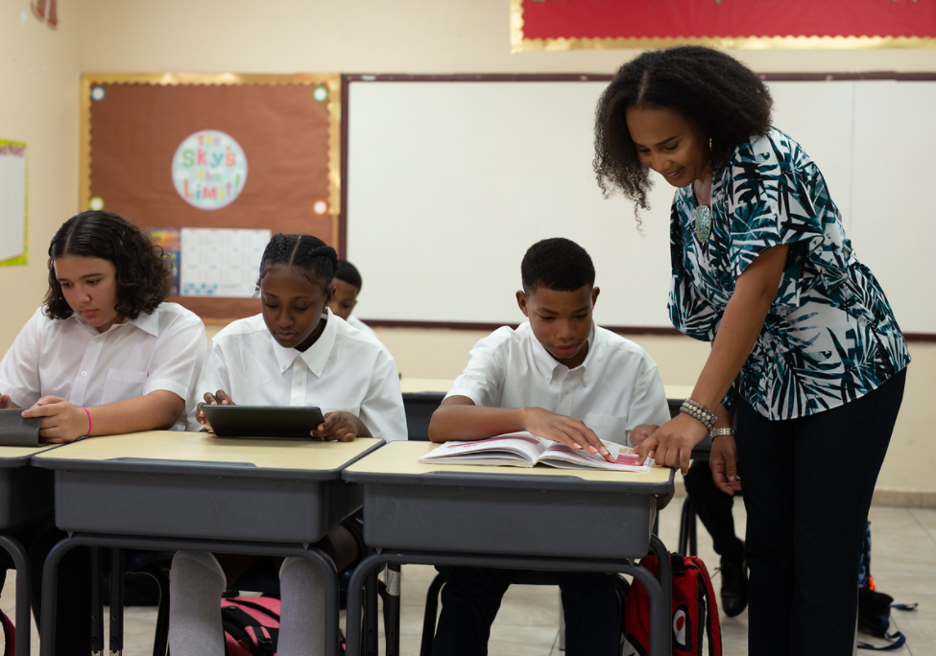Michele Merrell, Member of the Board and North American President GTWN and Member of the Board, Cable Bahamas and Aliv
The worldwide Digital Divide in society must end. We must implement an inclusive, digital ecosystem for all in the digital economy.
If there is any lesson we have learned from the pandemic, it is that the full-speed digitization of society is here to stay, and that all people – regardless of ethnicity, geography, or income – must have proper computing equipment, tablets and other devices, as well as access to digital platforms and high-speed internet to compete on an equal basis in the modern world.
Disparity between the “haves” and “have nots” has placed a glaring light on this devastating technology gap, as U.S. school children and others around the world were forced to suddenly participate in “in-home” learning versus in-person learning. And with that, we saw the homework gap of children who did not have laptops, tablets, or basic high-speed internet or even the ability to get online due to lockdowns. This has placed millions of children at a learning disadvantage from which they may not recover. School districts scrambled to deploy online learning platforms – something that many universities and colleges had implemented years ago. In some cases, schools offered live “Zoom” learning sessions, and in others, children were expected to find posted assignments and then access the content, complete assignments, and take tests, all with extremely poor learning results.
Adults, who were suddenly forced to work from home and conduct online business meetings and conference calls, found themselves in nearly impossible situations with slow internet service, cyber security concerns, and frustrating reliance on landline phones due to disparity in connectivity from cell towers. For individuals and companies to remain at pace with peers and society, access must be guaranteed, not only to the internet, but to crucial services including e-commerce platforms, digital payment methodologies and banking platforms and connected citizen services, including healthcare administration. With all this, there are ongoing cybersecurity issues that must be addressed to protect personal and workforce information. Additionally, digitization must take into consideration disabilities, language differences and many other important factors in how communities and individuals will interact with their devices, as well as the internet and broadband.
A lot of money has already been allocated…
Billions of dollars have now been funneled into school systems to aid in distance learning. In response to the economic and social fallout of the COVID-19 pandemic, the U.S. Congress passed on March 27, 2020, a $2.2 trillion economic stimulus bill, the Coronavirus Aid, Relief and Economic Security Act, also known as the CARES Act. $1.5 billion alone was allocated to American school systems. Funds were made available to help schools purchase devices for students who didn’t have them, and to help pay for broadband services. Little consideration was given to teaching disadvantaged students how to use these new devices or even how to access the new technology platforms they were required to now use! In the proposed $2 trillion dollar infrastructure plan now being debated in the United States in 2022, even more money is being allocated to close the Digital Divide and address massive broadband disparity in the U.S. Of this proposed amount, nearly $100 billion has been earmarked to expand broadband in rural communities. Sadly, this is not a one-stop fix for this situation – it will take ongoing efforts and additional spending in the billions for years to come to catch up on the disparity in devices, improved networks, and high-speed data delivery.
…but much more remains to be done
And despite all this money flowing in, children in the United States are still simply not ready for a newly connected digital economy. In a June 2020 study by Common Sense Education Superhighway and Boston Consulting Group cited that between 15 to 16 million students, or 30% of all public- school students live in households that do not have an internet connection, or an adequate device for distance learning, and in some cases, both. In the United States, roughly half of unconnected students come from families with annual incomes of less than $50,000. Students without a device or broadband were cut off almost entirely from their education. Because this issue resides mostly with students from lower income families, students of color, and those living in more rural communities, this failure to address the growing Digital Divide will continue to widen as students fall further and further behind.
Many advocacy groups and organizations are pushing for action as tens of millions still do not have proper access to affordable broadband, and even more, perhaps upward of 120 million, do not have internet at broadband speeds. Kajeet is sending Wi-Fi-enabled buses into neighborhoods that lack proper Wi-Fi. zSpace is delivering laptops with built-in 3-D capabilities so students can perform lab experiments from home. EveryoneOn is a non-profit that connects low-income families to affordable internet service and computers. Even the free app CloudCheck helps people find the strongest internet signal in their homes.
Why does resolving the digital divide matter?
Worldwide, it is essential that all people have equal access to distance learning because it prepares and ensures for proper workforce development and readiness for the next generation. Many studies also show that receiving a quality education breaks the cycle of poverty. Overcoming the Digital Divide gives greater access to employment opportunities, job training and other benefits including proper healthcare. With the pandemic surging on and off, with no clear end in sight so far, the ability to pivot back and forth between in-person and distance learning is essential. The same applies to those who were suddenly – and now consistently – forced to flex between onsite working and remote working from home due to ongoing pandemic surges.
Showing the way: digitalization of schools in The Bahamas

Technology has become one of the greatest drivers in social and economic development worldwide. Technology-enabled learning is a must to reform the educational curriculum and to promote sustainable development. There are many projects being developed in smaller, poor communities around the globe, which demonstrate how industry can work with governments, public companies, and not-for-profits to speed up the digitalization of the school system, and thus vastly improve the prospects for the next generation.
One such example is The Bahamas, where I am proud to be working with Aliv, the newest mobile telecommunications company in The Bahamas, and a technology-driven incubation hub for enterprises and expanding start-ups in the Caribbean region. Aliv is a fully Bahamian company rooted in local culture, with Bahamian talent, innovation, and tenacity at its forefront. Overcoming the Digital Divide in The Bahamas is a key objective of newly appointed Aliv CEO John Gomez, who has set out his main objectives for ensuring digital inclusion:
“Aliv exists to push forward the fastest mobile telecom data speeds for the archipelagic island nation, and to champion innovation and entrepreneurship by creating a tech-hungry and tech-confident Bahamas. We are acting together in partnership with the government, the education system on the islands, other technology partners and our customers to bridge the education gap and digital divide. We are aiming to help transform the teaching and learning experience in The Bahamas and help ensure that all Bahamian children have access to digital infrastructure and content so that they can fully participate in the digital economy.” - John Gomez, Chief Executive Officer & Group Head Consumer Business.
In November 2019, the Department of Transformation and Digitization (DTD) was officially launched by the Government of The Bahamas. It is an initiative to make all major government services accessible on online platforms for their citizens, thereby creating a more effective and seamless process for business to be conducted both locally and internationally with the government. Funded by a $30 million loan by the Inter-American Development Bank (IDB), the project will be completed within phases over the course of 6 years. The project’s goal is to foster the competitiveness of The Bahamas. Indeed, Grand Bahama has attracted international call centers and business process outsourcing and has the infrastructure to host data centers and security services, including cyber security. The Bahamas recently accelerated efforts to promote Grand Bahama as a technology and innovation hub to attract technology incubators, labs and research facilities with the support of U.S. company Cisco. This will create a plethora of new job opportunities and push the education system in The Bahamas to embrace more technical skills for students who will eventually benefit from jobs in technology.
A call to action
The private and public sectors must come together to deepen investments in high-speed broadband networks. In the U.S., the House and Senate must work together to bring this important first step for affordable, reliable broadband and digital skills to every American. Investing in future-proof scalable technology like fiber, and partnering with smaller, community-based local exchange providers, municipalities need to focus on delivering affordable services.
Fiber has been very successful bringing connectivity to urban and suburban areas, but what about the continuing challenge of the last mile to rural settings? For many years now, satellites have provided backhaul and trunking services for telecommunications and Internet Service Providers. Now, a new generation of direct-to-home satellites are being touted as the solution for remote areas. Indeed, several operators are having remarkable success in bringing high through-put broadband internet to remote areas and islands. Companies such as Kacific which practice one of the new business models of bringing together the private and public sectors through dedicated island and country-specific Ka-Band spot beams are overcoming challenges regarding cost and speed of satellite-based broadband services in the Pacific. Elon Musk’s Starlink venture is launching thousands of satellites in clusters to deliver connectivity in rural areas, but there are now questions about the long-term viability, efficiency, and impact of this approach.
In my view, a much more coordinated and concerted effort is needed from the tech industry, to ensure that there is an efficient use of resources and talent to overcome the Digital Divide wherever it exists. If we are to set our objectives for the next 30 years of the digital tech industry, we should take our example from places such as The Bahamas and show the type of determination and tenacity that is needed to the cause of overcoming the Digital Divide.
Michele M. Merrell is a senior level technology and telecommunications executive with 30 years experience in organizations ranging from start-up to mature, private, public and pre-IPO. She is the President of Merrell Consulting Group, a global consulting consortium. She has worked on numerous mergers, acquisitions and joint venture agreements, as well as IPOs during her tenure. Her experience includes companies such as Tyco International, Brightstar, CSPI Technology Solutions, Thales eSecurity, Bellsouth, U.S. Cellular and others. She has held broad global responsibility across APAC, EMEA, LATAM and North America. Since 2014, Michele has served on the Board of Directors for three international corporations, Cable Bahamas, Summit Broadband and Aliv Mobile Telecommunications. She is the head of the Corporate Governance & Nominating Committee for all three organizations, and also sits on the HR & Compensation Committee. She is a National Association of Corporate Directors accredited Board Leadership Fellow. Michele is on the international board of directors for the Global Telecom Women’s Network (GTWN), and is the North America President for GTWN, an organization that actively promotes and mentors women in the global telecommunications and technology industries. Michele was also named to the Board of Directors for the LeMieux Center for Public Policy.




